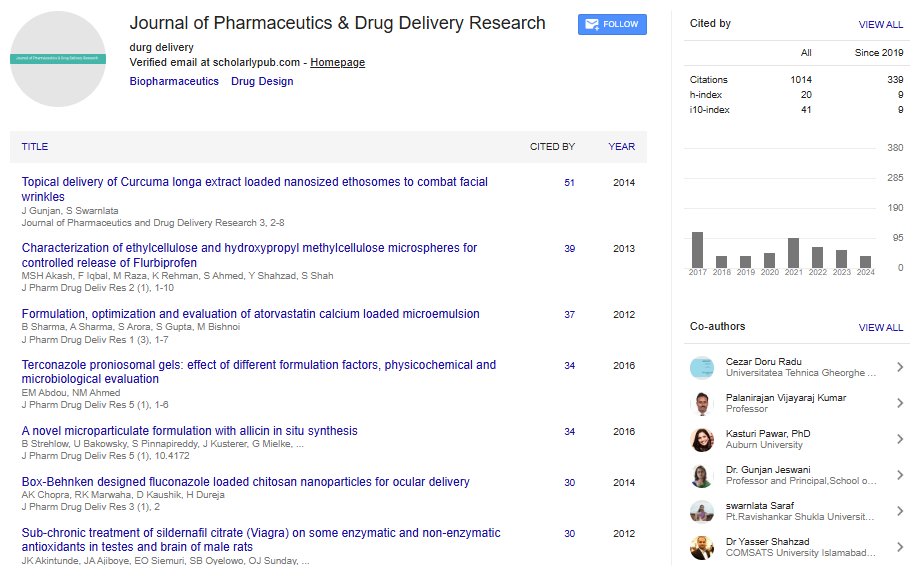Opinion Article, J Pharm Drug Deliv Res Vol: 13 Issue: 5
Key Properties of Drugs: Knowing Their Role in Efficacy and Safety
Yehua Xie*
1Department of Pharmacy, Lodz University of Technology, Zeromskiego, Poland
*Corresponding Author: Yehua Xie,
Department of Pharmacy, Lodz University of
Technology, Zeromskiego, Poland
E-mail: xiey378@gmail.com
Received date: 26 August, 2024, Manuscript No. JPDDR-24-151935;
Editor assigned date: 28 August, 2024, PreQC No. JPDDR-24-151935 (PQ);
Reviewed date: 11 September, 2024, QC No. JPDDR-24-151935;
Revised date: 18 September, 2024, Manuscript No. JPDDR-24-151935 (R);
Published date: 26 September, 2024, DOI: 10.4172/2325-9604.1000301
Citation: Xie Y (2024) Key Properties of Drugs: Knowing Their Role in Efficacy and Safety. J Pharm Drug Deliv Res 13:5.
Description
The effectiveness and safety of any pharmaceutical product are influenced by various drug properties. These include physical and chemical attributes that impact a drug's behavior in the body and its interaction with biological systems. A thorough understanding of these properties is essential for developing drugs that are both effective and safe for patients.
Solubility refers to a drug's ability to dissolve in a particular solvent, such as water or lipids. For drugs administered orally, water solubility is precarious because it affects absorption in the gastrointestinal tract. Drugs with low water solubility often face challenges in being absorbed efficiently, which can lead to lower bioavailability and reduced efficacy. Some drugs require formulation modifications, like the use of solubilizes, to enhance their solubility and ensure effective absorption.
Bioavailability measures the fraction of an administered dose that reaches systemic circulation and is available to produce a therapeutic effect. It is affected by multiple factors, including the drug's formulation, its solubility and the route of administration. Oral drugs often have lower bioavailability than those administered intravenously, as they pass through the liver first (first-pass metabolism), where a portion of the drug may be metabolized before reaching systemic circulation.
Partition Coefficient (Log P) The partition coefficient (Log P) is a measure of a drug's lipophilicity, or its affinity for lipids compared to water. Drugs with a high Log P are generally more lipophilic and can easily cross cell membranes, potentially enhancing absorption. However, extreme lipophilicity can also cause drugs to accumulate in fatty tissues, leading to prolonged elimination times and potential toxicity. An optimal Log P ensures the drug can cross cell membranes without leading to unwanted side effects.
Molecular Weight and Size Molecular weight and size play precarious roles in determining how easily a drug can be absorbed, distributed and eliminated by the body. Larger molecules are often poorly absorbed through cell membranes and may require injection or alternative delivery methods. Drugs with a smaller molecular size tend to diffuse across biological membranes more readily, improving absorption.
pKa and Ionization A drug’s pKa is the pH at which it is 50% ionized and 50% unionized. Since only unionized forms of drugs can usually cross cell membranes, a drug’s pKa can influence its absorption and distribution. For instance, weak acids tend to be better absorbed in the acidic environment of the stomach, while weak bases are better absorbed in the basic environment of the intestines. Understanding the ionization properties can help in optimizing a drug’s absorption profile.
Stability refers to a drug’s ability to maintain its chemical integrity and potency over time. Drugs that are unstable may degrade, resulting in reduced efficacy or even harmful byproducts. Stability can be influenced by factors like temperature, light and moisture. Ensuring a drug's stability is vital for its safety and efficacy, which is why pharmaceutical formulations often include stabilizers to prolong shelf life.
Binding Affinity and Selectivity Binding affinity and selectivity determine how well a drug binds to its intended target, such as a receptor or enzyme, compared to other sites. Drugs with high binding affinity and selectivity are generally more effective with fewer side effects, as they interact mainly with the desired biological targets. High selectivity also helps in reducing off-target effects, which can lead to adverse reactions.
Metabolism and Excretion Drug metabolism, often occurring in the liver, is the process by which a drug is chemically altered, typically to facilitate excretion. Metabolism affects a drug’s duration of action and potential side effects. Understanding metabolism is essential for predicting interactions with other drugs and determining the appropriate dosing regimen. Excretion, primarily through the kidneys, removes drugs from the body. Drugs that are not efficiently excreted may accumulate, leading to toxicity, especially in individuals with impaired kidney or liver function.
Conclusion
Each property of a drug contributes to its overall effectiveness and safety profile. By carefully evaluating properties like solubility, bioavailability, stability and binding affinity, scientists and pharmaceutical companies can optimize drugs for therapeutic success. Understanding these properties is essential for clinicians in selecting the most suitable medications for patients, ultimately leading to better health outcomes and improved patient safety.
 Spanish
Spanish  Chinese
Chinese  Russian
Russian  German
German  French
French  Japanese
Japanese  Portuguese
Portuguese  Hindi
Hindi 
